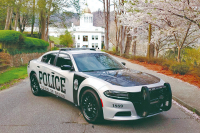Shrills in the night
When I was growing up in the tobacco-farming portion of the southern Virginia piedmont, there were many haunted outbuildings throughout the region. My friends and I knew they were haunted because we would nightly, from early spring into early fall, hear ungodly shrieks and hisses emanating from them. My Uncle Will smoked his pipe and told us stories about the “monkey demons in the rafters.”
I was perhaps 10 years old before I realized that the denizens of these rural outbuildings weren’t “monkey demons.” That was when I saw a white form glide across the pasture and into the opening under a barn roof. Flashlight in hand, I climbed the rickety stairway to the loft and focused the beam on a hunched, monkey-faced figure in a far corner. He (or she) swayed its lowered head side-to-side, made a raspy irritated screech followed by an eerie “shrrreeee,” and then turned a disgruntled back to the light before suddenly exiting the way it entered.
I now knew that the so-called demon was an owl, but it took me awhile to determine that it was a barn owl. In those days in Virginia these owls were fairly common. Just about every farm had a resident pair. They were even brazen enough to nest in church steeples and other man-made cavities in town.
But these days, barn owls are becoming decidedly uncommon, if not rare, due to the loss of open grasslands where they can hunt meadow voles, perhaps the principal ingredient in their diets. Another factor in their decline is the loss of abandoned outbuildings and natural tree cavities in which they can nest and breed.
Barn owls were never so common in the mountains of Western North Carolina as in the piedmont and coastal areas. I’ve spotted just three of them in the 34 years that we’ve lived in the Smokies region. One I saw at dusk gliding over the road that leads to my house. Another appeared in the fields adjacent to the John C. Campbell Folk School. And the third was in the vast Ferguson Fields (now a part of the Cherokee Indian reservation called Katuwha) alongside the Tuckaseigee River just east of Bryson City.
But they’re reported from Western North Carolina in the birding literature with some regularity. It’s possible they’re still found in modest numbers in those counties like Cherokee, Macon and Haywood that still have large open fields and farm outbuildings.
Related Items
If there are barn owls on your property, you no doubt know they’re there since they are raucous noisy birds when nesting or roosting. Their appearance is unmistakable: upper parts that are light golden-brown sprinkled with small black and white spots; white under parts; and an indented heart-shaped face that serves as a highly sensitive parabolic dish capable of absorbing even very faint sounds. This odd facial pattern has resulted in the common name of “monkey-faced owl” in some areas of the country.
It has been estimated that, “The barn owl may in fact be this country’s most efficient natural rodenticide. An individual owl will usually take two to four vole-sized prey each night. An adult barn owl pair with young may actually take 15 to 40 small rodents each night (depending upon clutch size). Since the young fledge at about 10 weeks, some 1,000 to 3,000 small rodents may be taken during one nesting period, in one given barn owl territory. Barn owls have been known to produce three broods each year, ranging in size from three to 14 (usually five). A productive pair with young could take some 3,000 t0 9,000 small rodents per year, not to mention the rodents preyed upon after fledging and dispersal of the young from the nest site.”
That’s why Uncle Will — who wasn’t a bird-watcher by any stretch of the imagination — not only tolerated but encouraged the “monkey demons” to reside in his barns.
If you do have a resident pair of nesting barn owls, I would appreciate hearing from you via either a letter or email. I will pass that information along to the appropriate conservation authorities. Please let me know your name, address, telephone number, type of nest site, and how many years the birds have been using the site.
George Ellison wrote the biographical introductions for the reissues of two Appalachian classics: Horace Kephart’s Our Southern Highlanders and James Mooney’s History, Myths, and Sacred Formulas of the Cherokees. In June 2005, a selection of his Back Then columns was published by The History Press in Charleston as Mountain Passages: Natural and Cultural History of Western North Carolina and the Great Smoky Mountains. Readers can contact him at P.O. Box 1262, Bryson City, N.C., 28713, or at This email address is being protected from spambots. You need JavaScript enabled to view it..









